To provide you with the most up-to-date information on golf course and driving range lighting, we present this comprehensive guide. It will serve as a valuable reference for answering all your questions about layout and design. We will cover both general golf course lighting standards and lesser-known considerations. By the end, you will have a clearer understanding of what is required for your golf course and the reasons behind it.
Let’s delve into the essentials of what you’ll need and why.
Table of Contents
ToggleWhat Lights Are Used on the Golf Course?
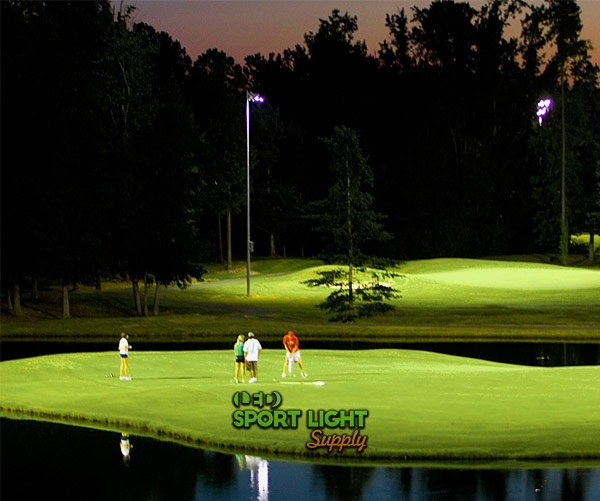
Flood Lights
Flood lights are often associated with illuminating large areas, but their application on golf courses is somewhat different. Contrary to common misconceptions, flood lights are used for short-range lighting with large beam angles. On a golf course, these lights are typically mounted on shorter poles to ensure better lighting uniformity. The large beam angles, ranging from 45 to 90 degrees, help distribute light evenly across the course while minimizing light pollution. The use of multiple flood lights ensures that the entire area is well-lit and evenly covered.
Spotlights

Spotlights, despite their name, serve a distinct purpose in golf course lighting. They are designed for long-range illumination with a narrow beam angle. For instance, a spotlight with a 10-degree beam angle can effectively light up distances of 200-300 meters on a driving range. The beam angle of a spotlight needs to be sufficiently wide to cover long distances, which is why these lights are often mounted on taller poles. This setup ensures that the light can travel the required distance and provide adequate illumination.
High Mast Lights
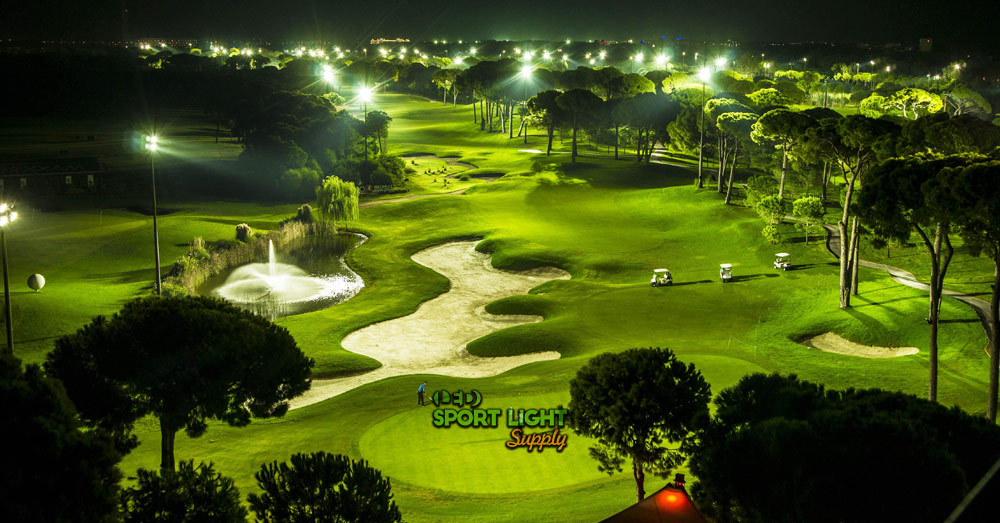
High mast lights are mounted on very tall poles, starting at a height of 30 meters. These lights are essential for illuminating large areas of a golf range, especially when spotlights alone are not sufficient. Due to their height, high mast lights must be stabilized to withstand high winds and equipped with lightning rods and copper wiring to safely manage lightning strikes. Accessibility for maintenance, typically using crane lifts or climbable designs, is also a key consideration for high mast lighting systems.
High Bay Lights
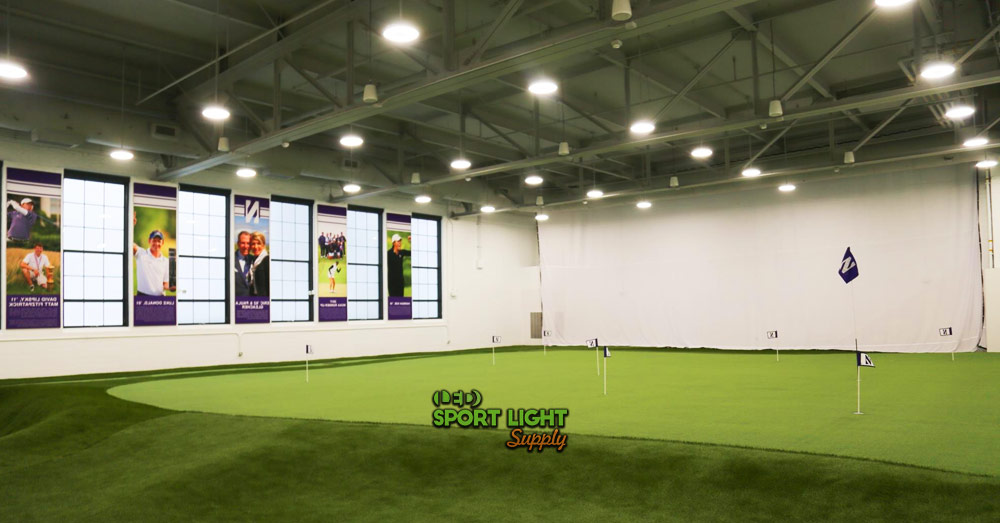
High bay lights are commonly used for indoor golf simulators and driving ranges. These lights are mounted on the roof and provide downward illumination. The spacing of high bay lights is determined by a spacing chart that takes into account the height of the roof and the angle of the lamps. For semi-enclosed driving ranges, lighting fixtures can be placed above the Tee Off platform to ensure broader illumination over greater distances. High bay lights are ideal for indoor settings where space and lighting requirements differ from outdoor golf courses.
How to Get Started with Golf Course and Driving Range Lighting Design
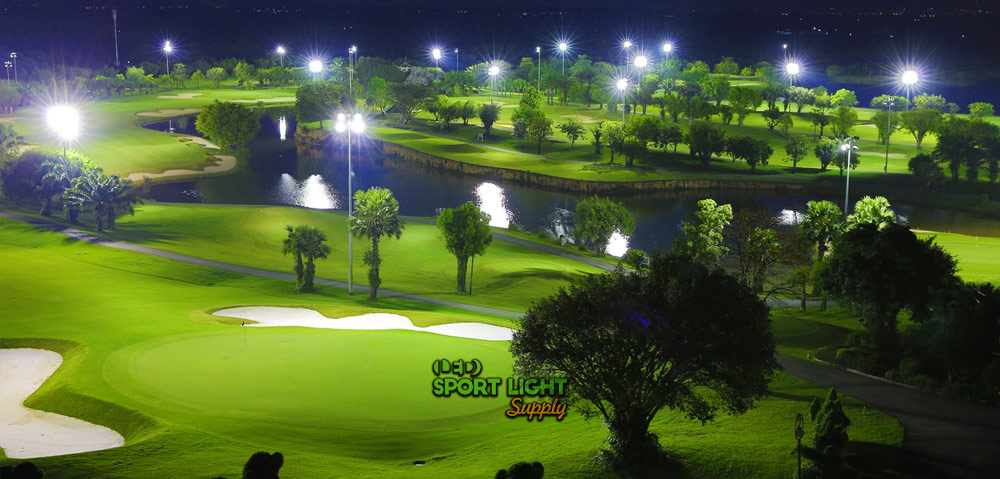
Horizontal Illuminance (Lux and Footcandle) Requirements
Horizontal illuminance measures the amount of light falling on a surface horizontally. This is typically assessed using a Lux meter placed 1 meter above the golf course grass. The following are general guidelines for different types of golf facilities:
Golf Course
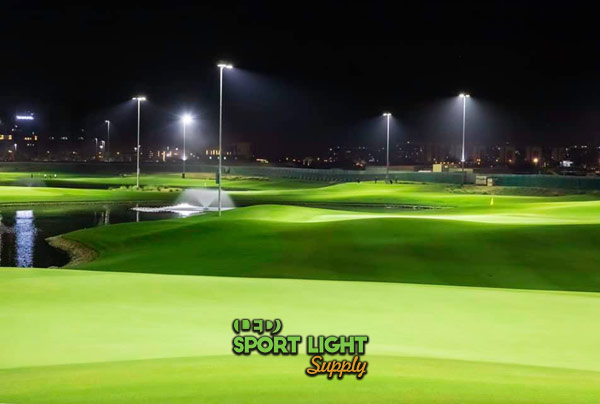
Recreational
For recreational golf courses, the standard Lux levels range from 100 to 300 Lux. This level of lighting is comparable to what you might find in a living room or office setting. It allows players to see the key details of the course, such as sand traps and golf holes. Upgrades to this lighting might be necessary for special events, such as local televised tournaments, where temporary lighting can be added.
Professional
Professional golf courses and driving ranges require significantly brighter lighting, ranging from 500 to 800 Lux. This level of illumination is similar to the lighting found in supermarkets or libraries and ensures that all course details, including the ball and course features, are clearly visible. It is particularly beneficial for players with aging eyesight and provides optimal conditions for professional golfers.
National and International Tournaments
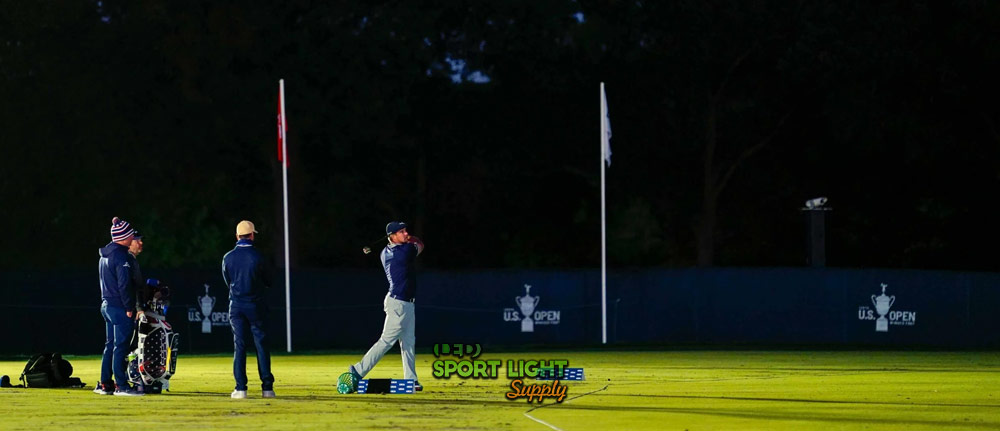
Major tournaments like the Masters Tournament and the US Open demand extremely high Lux levels, typically between 1000 and 2000 Lux. This intense lighting is necessary for capturing detailed images with slow-motion cameras and ensuring the clarity of televised coverage. The lighting levels are comparable to those used in examination lamps in medical offices or high-detail aerospace settings.
Driving Range
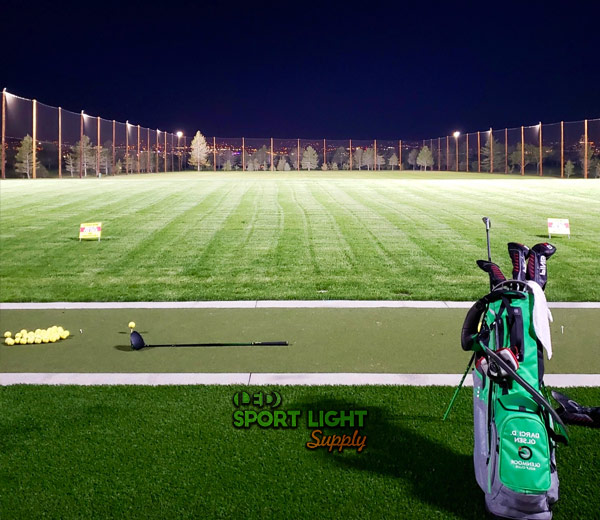
Golf Practice
For outdoor driving ranges, which are primarily used for practicing swings and tracking ball landing, a Lux level of 100 to 200 is sufficient. This level of lighting allows players to see where their ball lands and is typically adequate for public practice ranges, which may feature open fields or semi-covered individual stations.
Vertical Illuminance for Golf Driving Ranges
Vertical illuminance measures light in vertical planes and is important for assessing visibility along different directions. For golf courses, measurements should be 100 to 300 Lux at a height of 3 meters, with readings taken in four directions: North, South, East, and West. This ensures that all areas of the course, including the driving range, are adequately illuminated for accurate distance measurement.
Lighting Uniformity for Golf Course and Driving Range
Recreational
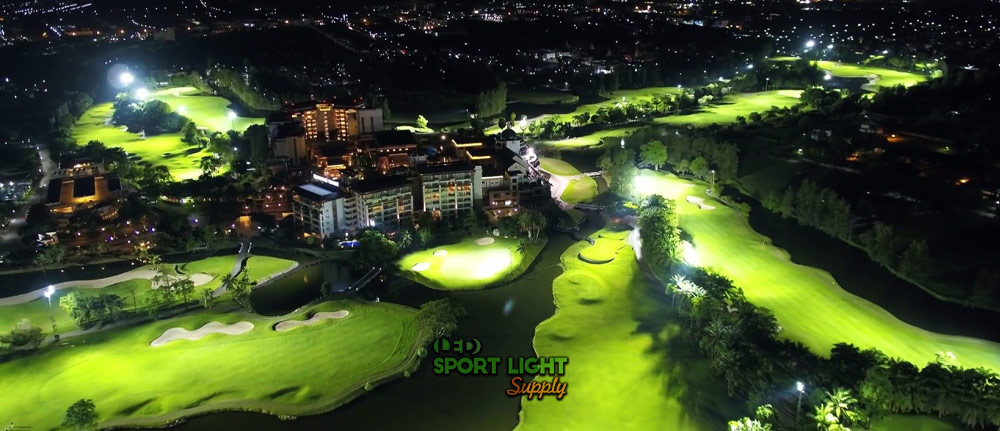
For recreational golf courses, lighting uniformity is measured across square meter sections, with a recommended average of 0.4 to 0.5. This ensures that key areas of the course are sufficiently lit, though some variation in light levels is acceptable.
Professional
Professional golf courses require higher uniformity levels, ranging from 0.5 to 0.6. This is achieved through stronger lighting and additional poles, ensuring consistent illumination across the entire course and making it visually appealing for both players and viewers.
Color Temperature
Color temperature affects the hue and appearance of light. For driving ranges, a color temperature of 2800K to 5000K is typical, while professional golf courses often use 5000K lights for a more natural and daylight-like illumination. Recreational courses might opt for warmer, more soothing light temperatures.
Color Rendering Index (CRI)
The CRI measures how accurately a light source reveals colors compared to natural light. For televised events, a CRI of >85 is essential to prevent color distortion and ensure high-quality image capture. This is particularly important for major tournaments and broadcast coverage.
Beam Angle
Beam angles determine the spread of light. For long-range lighting, beam angles of 10 to 25 degrees are used, while shorter-range lighting utilizes angles of 45 to 90 degrees. Taller poles are generally used for lower beam angles to minimize light flare and ensure comfortable visibility for golfers.
Flicker-Free Lighting
Flicker can affect both visual comfort and camera performance. LED lights are preferred for their flicker-free operation, crucial for broadcasting and slow-motion recording. Their high-frequency flicker is imperceptible to the human eye but is managed effectively by digital cameras, ensuring smooth, clear images.
Golf Course and Driving Range Lighting Layout
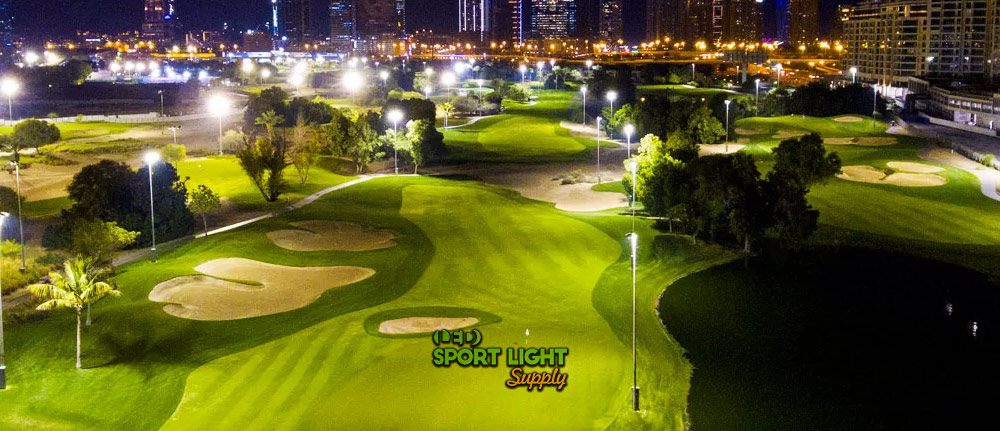
Light Pole Height
Light pole height varies across a golf course depending on the specific needs of the area. For driving ranges, taller poles are necessary to provide sufficient illumination over a larger area, with typical heights reaching up to 30 meters. In contrast, poles used for closer range lighting are generally shorter, around 15 meters in height. Adjusting the height of the poles helps to minimize light pollution and light bleed while ensuring adequate coverage. Taller poles use lower beam angles to reduce glare and flare, which improves visibility and comfort for players.
Number of Poles
The number of light poles required for a golf course depends on the desired coverage and layout of the course. A single high mast light pole can cover a radius of 50 to 200 meters. Using just one pole for such a large area can lead to insufficient illumination and light pollution. To achieve optimal lighting, it is crucial to determine the correct number of poles based on the golf course’s design and topography. Hills, slopes, and other landscape features can create shadows, necessitating a well-planned lighting strategy to ensure uniform coverage and avoid dark spots.
Pole Position
The positioning of light poles is critical for effective illumination. While it might seem logical to place poles along the edges of the golf course, this can be challenging due to obstacles such as tall trees, hills, and slopes that create shadow zones. Therefore, some poles need to be strategically placed within the course to ensure comprehensive lighting. The height of each pole must be carefully considered to ensure that all playing areas, including each hole, are adequately lit. Strategic placement within the course helps to control shadows and achieve uniform lighting coverage.
Flood Lights Angle of Projection
The angle of projection for flood lights is an essential aspect of the lighting layout. Each pole’s angle must be mapped out to ensure that the illuminated sections overlap appropriately and that there are no blind spots. The topography of the golf course can affect the effectiveness of lighting, as different terrain features can impact light distribution. Creating a detailed lighting map or using trial and error methods can help to address potential issues and refine the lighting design. Proper planning is essential to avoid mistakes and ensure that all areas are evenly illuminated.
Common Mistakes in Golf Course Driving Range Lighting Design
Using the Wrong Beam Angle
Selecting the incorrect beam angle can lead to several lighting issues. For example, using a 15-degree beam angle for illuminating close-range areas can result in overly bright spots. This occurs because a lower beam angle requires a longer distance to distribute light effectively. To avoid this problem, a wider beam angle should be used for shorter distances. Properly estimating the needed beam angle can be challenging, making pre-planning and consulting with lighting professionals essential for effective design and installation.
Golf Course Lighting is Too Dim
Insufficient illumination is a common issue, particularly if golf holes are difficult to see. Dim lighting may result from using flood lights intended for shorter distances or from improper pole height and lumen output. While recreational courses may experience this problem due to inaccurate lighting estimates, professional courses benefit from the expertise of lighting specialists who conduct detailed assessments to achieve optimal lighting levels.
Driving Range Lighting is Too Bright
Overly bright lighting can cause discomfort for golfers and waste energy. Excessive brightness often results from using lights with high color temperatures above 5000K, which can lead to blinding effects and washed-out colors. Even if lights are equipped with dimmers, if they were not designed for dimming, this can create further issues. Ensuring the correct color temperature and proper CRI (Color Rendering Index) is crucial to avoid glare and maintain visual comfort.
Too Low Lighting Uniformity
Inadequate lighting uniformity can create uneven illumination, with some areas appearing too bright or too dim. Proper uniformity is essential for a professional appearance and a positive user experience. Without consistent lighting, the golf course can look less refined, impacting both playability and aesthetics. This issue is often encountered when golf course owners attempt to manage lighting independently without professional guidance.
How to Fix Common Lighting Issues
To address these common lighting problems, seeking professional advice is highly recommended. We offer a free DIALux lighting simulation, a comprehensive photometric study that visualizes your golf course in 3D graphics. This simulation allows us to plot lighting positions and predict outcomes, including horizontal and vertical Lux levels and light uniformity. Additionally, the simulation can identify and correct issues such as glare and GR rating concerns.
By providing accurate details about your golf course, the simulation helps to predict and address potential blind spots before installation. This ensures that the final lighting setup meets all requirements and eliminates any missed areas.
Our Conclusion
We hope this guide has enhanced your understanding of golf course lighting. If you have any further questions or need assistance with improving your course lighting, we are here to help. With extensive experience in designing lighting solutions for golf courses, we know what works and what doesn’t. Feel free to reach out with any inquiries about golf course lighting design and layout.
